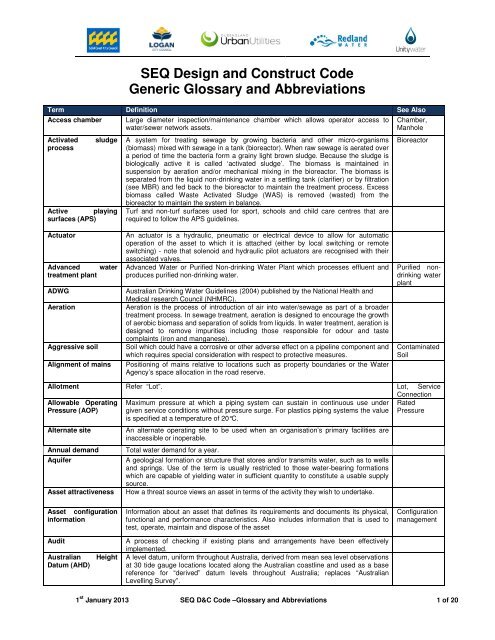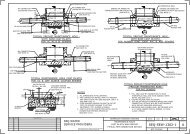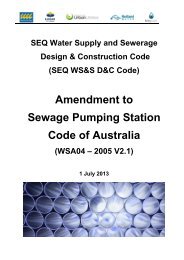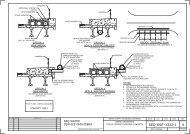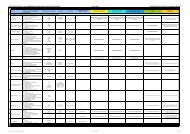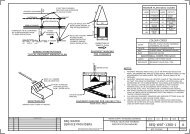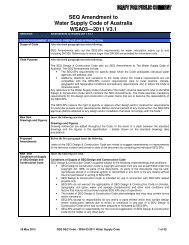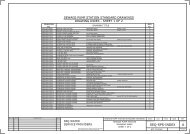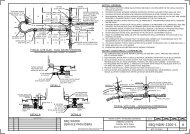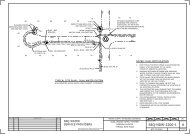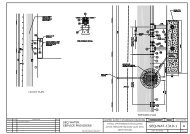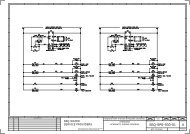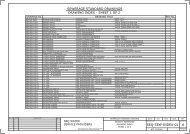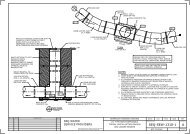Glossary & Abbreviations - SEQ Design and Construction Code
Glossary & Abbreviations - SEQ Design and Construction Code
Glossary & Abbreviations - SEQ Design and Construction Code
- No tags were found...
You also want an ePaper? Increase the reach of your titles
YUMPU automatically turns print PDFs into web optimized ePapers that Google loves.
Term Definition See AlsoCustomerst<strong>and</strong>ardsserviceA document developed by a water service provider to inform customers who do nothave contracts with the service provider of the level of service st<strong>and</strong>ards.DamData storageDead waterDeclaredserviceDem<strong>and</strong>waterAn artificial structure, whether permanent or temporary, built as a barrier to retain orimpound a volume of water, including the storage area created by the structure <strong>and</strong>the embankments or other structures that control the flow of water or are incidental tothe main structure.Data storage devices are IT equipment used to store digital data <strong>and</strong> can include harddisc drives, backup tape recorders, optical discs etc.Water that is not useable. For example, water below the outlet level of a reservoir ortank <strong>and</strong>/or water that has deteriorated due to excessive detention (through pooroperational flow, dead ends or other operational means).A water service declared by the Minister under Chapter 2A, Part 5a, Division 2 of theWater Act 2000.Volume of water used by customers during a certain time interval from a water supplysystem. Can be a measure of individual usage or collective use.Dem<strong>and</strong> forecastingProcess of anticipating volumes of water required to meet current <strong>and</strong> projectedcustomers’ peak (maximum) hourly, daily <strong>and</strong> annual requirements.De-rating Refer to “fatigue de-rating”. Fatigue derating,temperaturede-rating,Operatingpressure limitDesalination The removal of salt from seawater or brackish water to produce drinking water, usingvarious techniques.Desalination plant<strong>Design</strong> capacity(“nameplate”)<strong>Design</strong> period<strong>Design</strong>(DP)PressuresA treatment facility which undertakes removal of salts from seawater or other salinesources (e.g. groundwater) by distillation, chemical reactions or use of membranes.The capacity of an asset as intended in the original design of the facility. May differfrom the actual capacity of the asset.Period of time a design analysis should cover in order to size system facilities (such asservice reservoirs, pumping stations <strong>and</strong> water filtration plants). It is typicallyexpressed as the number of consecutive days that the daily dem<strong>and</strong> factor exceedsthe ratio of supply (or input) capacity to maximum day dem<strong>and</strong>.Limiting pressures, both maximum <strong>and</strong> minimum, that the designer allows for in thedesign of a pipeline system. These pressures are used to determine:• the extent of the proposed development that may be serviced, in terms ofelevation (acceptable range of residual pressures) <strong>and</strong> distance (acceptableminimum residual pressure after head losses)• a suitable pipe material to meet expected operating pressures for the durationof the system life, <strong>and</strong>• structural requirements associated with the pipeline pressureDirect tappingDisinfectionDissolved AirFlotation (DAF)Distribution mainDistribution networkA procedure consisting of drilling <strong>and</strong> tapping the pipe wall followed by insertion of atapping valve/maintap. A “wet” tapping is one undertaken while the mains remainonline. A “dry” tapping is one undertaken when the mains are offline.Inactivation or removal of pathogenic micro-organisms.A process for incorporating air bubbles to induce separation of solids <strong>and</strong> impuritiesform the raw water or sewage stream.A water main serving as the principal distributor within the supply area, normallywithout direct consumer connections.A combination (network) of larger diameter water mains necessary to ensure anadequate supply of water to, <strong>and</strong> within, reticulation networks (systems).TrunkDistributionmain1 st January 2013 <strong>SEQ</strong> D&C <strong>Code</strong> –<strong>Glossary</strong> <strong>and</strong> <strong>Abbreviations</strong> 5 of 20
Term Definition See AlsoDistributor-retailersDiurnal pressurevariationDomestic meterProviders of water services to individual customers/groups of customers. Services tothe South East Corner are specified in the South-East Queensl<strong>and</strong> Water (Distribution<strong>and</strong> Retail Restructuring) <strong>and</strong> Natural Resources Provisions Act 2009 <strong>and</strong> serviceproviders include Allconnex Water, Queensl<strong>and</strong> Urban Utilities <strong>and</strong> Unitywater.A daily variation in system pressure, at any location, between periods of high <strong>and</strong> lowwater usage (normally between day <strong>and</strong> night).Meter on a residential service connection for the purpose of measuring waterconsumption <strong>and</strong> associated billing.<strong>SEQ</strong> ServiceProviders(<strong>SEQ</strong>-SP)Drinking water Water that is suitable for human consumption, food preparation, utensil washing <strong>and</strong>oral hygiene.PotableWater,Purified nondrinkingwaterDual Service Refer “Split Service” Split ServiceDual reticulationDuplicate mainDynamic pressureheadEasementEconomic analysisThe supply of water from two separate sources, requiring two sets of pipes: one toprovide drinking water (for drinking, cooking, bathing <strong>and</strong> laundry purposes); the otherto provide appropriately treated non-drinking water (e.g. raw water or non-drinkingwater) for purposes such as toilet flushing, garden watering/irrigation <strong>and</strong> otherexternal uses or industrial applicationsAn additional main, laid parallel to the original main (usually on the other side of theroad), to service allotments that cannot be easily serviced from the original main.When a pump is operating, vertical distance from a reference point (such as a pumpcentre line) to the hydraulic grade line.A right held by one party to make use of the l<strong>and</strong> of another for certain purposes.Assesses the overall impact of a project on the local, regional or state economy.Rider MainStatic headEconomically viableEffluentEmergencyEmergencymanagementEmergencyoperatinginstructionsEmergencyresponse planEnergydeviceEngineered fillrecoveryEnvironmentaloutcomes or impactsEvaluation of whether the gains from a project outweigh the costs of a project.Economic evaluation is undertaken from the perspective of the economy as a whole<strong>and</strong> does not differentiate between winners <strong>and</strong> losersTreated or untreated liquid waste flowing from a sewage treatment plant or fromagricultural <strong>and</strong> industrial processes.A situation or occurrence that happens as a consequence of an incident <strong>and</strong> dem<strong>and</strong>simmediate action. A an ‘emergency’ is an incident that impacts on water quality, watersupply reliability <strong>and</strong>/or public reassurance, <strong>and</strong> has an overall severity rating of Level3, 4 or 5 under the severity classification approach outlined in this Plan.The emergency response function largely involving strategic comm<strong>and</strong> <strong>and</strong> externalcommunications.Emergency Operating Instructions issued by the Water Grid Manager.A plan prepared by the Water Grid Manager or by a Grid Participant in accordancewith the Market Rules.Including micro hydro or similar assets for generation of energy from watermanagementFill that has been selected, placed <strong>and</strong> compacted to meet specified performancecriteriaThese include efficient resource use, environmental impacts, <strong>and</strong> environmentalcompliance.Equivalent(EP)PersonThe water supply dem<strong>and</strong> or the quantity <strong>and</strong>/or quality of sewage discharge for aperson resident in a detached house. It is also applied to:• The number of persons who would have a water dem<strong>and</strong> equivalent to theestablishment being considered.• The number of persons who would contribute the same quantity <strong>and</strong>/orquality of domestic sewage as the establishment being considered.1 st January 2013 <strong>SEQ</strong> D&C <strong>Code</strong> –<strong>Glossary</strong> <strong>and</strong> <strong>Abbreviations</strong> 6 of 20
Term Definition See AlsoExternal water use /Dem<strong>and</strong>Water used externally in activities such as garden watering or irrigation, car washing,filling swimming pools.EventExerciseExisting surface levelExposureFatigue de-ratingFenceFilterFilter mediaFinancial analysisFinancial viabilityFire flow dem<strong>and</strong>An occurrence or change of a particular set of circumstances.An activity to practise or test plans <strong>and</strong> arrangements. This can involve a theorybased approach such as discussion or desktop exercise, a practical approach such asa deployment exercise, or a combination of both.Undisturbed ground surface, prior to adjustment as part of the development works.Extent to which an organisation <strong>and</strong>/or stakeholder is subject to an event.An allowance made, during the design process, for the reduced pressure withst<strong>and</strong>ingcapability of products (particularly plastics) as a result of anticipated cyclic loadingswithin the system.A fence is a freest<strong>and</strong>ing structure designed to restrict or prevent movement across aboundary, which includes posts or stakes joined together by boards, wire, or rails,gates (<strong>and</strong> automation equipment if automated) <strong>and</strong> locks.An asset that uses replaceable media or a replaceable cartridge to filter particles froma fluid (e.g. a pressure s<strong>and</strong> filter or a cartridge filter). Assets recognised as this typewill include the filter media.Filter media is any media that is used to remove contaminants from water. It caninclude s<strong>and</strong> anthracite, garnet, manganese dioxide, granular activated carbon,dolomite <strong>and</strong> others depending on the type of application <strong>and</strong> is. Contaminants areremoved through straining <strong>and</strong>/or absorption depending on the chosen media.Evaluates the financial viability of a project from the perspective of the serviceprovider.A project is financially viable if the revenues from the project cover the project costs<strong>and</strong> earn a commercial return on investment.Financial evaluation is considered from the perspective of the project developer.Quantity of water required for fire fighting purposes often expressed as a flow rate for aparticular time period or from particular locations in the water supply system.Filter MediaFilterFire systemFittingFlexible jointFlexible pipeFlowmeterThis is an engineered set of components that work together to detect a fire, alertoccupants, <strong>and</strong> extinguish a fire. It may include the fire control panel, smoke detectors,heat detectors, alarms, VESDA fire detection, CO2 fire suppression <strong>and</strong> dedicated firepumps <strong>and</strong> pipework.A component of a pipeline, other than a pipe, which allows pipeline deviation, changeof direction or bore. In addition, valves, flanged-socketed pieces, flanged-spigotpieces, collars <strong>and</strong> couplings are also defined as fittingsA joint that permits limited, defined angular deflection, both during <strong>and</strong> afterinstallation, <strong>and</strong> which can accept a slight offset to the centrelineA pipe that relies primarily upon side support to resist vertical loads without excessivedeformation. Flexible pipe materials include PVC, GRP, <strong>and</strong> PE.A flowmeter is a device used for measuring flow through a particular point. A metermay be either a customer meter which is used to measure usage by an individualconsumer, a network meter which is used by field operations to measure usage at aparticular location on the network or a process meter to measure process flows attreatment plants. (Note measuring flumes are considered to be flowmeters).CustomerMeterFlushing point A specially designed flushing assembly, hydrant or scour. Scourfootpath A formed pavement for pedestrians, especially one at the side of a road in the footway. Footway,vergefootwayA strip of l<strong>and</strong> between the front boundary of a lot <strong>and</strong> the kerb or carriageway. It caninclude a footpath <strong>and</strong> is also known as nature strip (where it is not paved) or verge inCarriageway,vergesome regions of Australia.FrequencyA specially designed flushing assembly, hydrant or scour.Generator setAn asset comprising a primary drive source (e.g. a diesel engine) <strong>and</strong> an alternator togenerate electrical power.1 st January 2013 <strong>SEQ</strong> D&C <strong>Code</strong> –<strong>Glossary</strong> <strong>and</strong> <strong>Abbreviations</strong> 7 of 20
Term Definition See AlsoGravity systemGreenhouseemissionsGrid CustomerGrid InstructionsGrid ParticipantgasGrid Participant riskGrid Service ProviderHazardHead, HHold pointHurdle rateHydrantA system wherein flow <strong>and</strong>/or pressure are caused by the force of gravity. There aretwo kinds of such systems:• Pressurised gravity system, where the pipeline operates full, <strong>and</strong>• Non-pressurised gravity system, where the pipeline operates partially full[.]Emissions of gasses defined by the national pollution inventory as a greenhouse gasincluding “carbon dioxide (CO2), carbon dioxide equivalent (indirect), Methane(CH4),nitrous oxide (N2O), hydroflurocarbons (HFCs), perfluorocarbonbs (PFCs), <strong>and</strong>sulphur hexafluoride (SF6)”.A Customer of the Water Grid Manager as defined in Schedule 4 of the Water Act2000.Instructions prepared by the Water Grid Manager <strong>and</strong> given to the Water Grid <strong>and</strong>Distribution Service Providers in accordance with the Market Rules.An entity that is referred to in section 2.3 of the Market Rules.A risk, the consequence of which is wholly contained within that Grid Participant inwhich the risk arises.Has the meaning given in Schedule 4 of the Water Act 2000 <strong>and</strong> includes a BulkSupplier, Bulk Transporter <strong>and</strong>/or Manufactured Water Provider.A source of potential harm.Pressure expressed in terms of the height of a column of water (in metres head). Thehead is a factor of 9.81 (nominally 10) lower than the equivalent value in kPa, e.g. 800kPa @ 80 m headA point beyond which an activity may not proceed without the approval of a designatedorganisation or authorityThe rate of return which is required to be demonstrated to be able to be met before acapital investment project should be commenced; i.e. It is the level of profitability whichthe proposed project is required to exceed (or “hurdled”) to be accepted fordevelopment.A water hydrant is a special type of controllable fitting placed on trunk <strong>and</strong> reticulationmains for providing water for emergency use. There are two subtypes available –hydrant (spring) <strong>and</strong> offtake. The asset by definition includes its cover box.Hydraulic Grade Line(HGL)HydraulicsHydrologyIncidentIncidentmanagementInfrastructureleakage indexInfluentInternal rate of returnInternal water use /dem<strong>and</strong>Inherent robustnessA line (hydraulic profile) indicating the piezometric level of flow at all points along aconduit, open channel or stream. In pipes under pressure, each point on the hydraulicprofile is an elevation expressed as the sum of the height associated with the pipeelevation <strong>and</strong> the pipe pressure (head).The science that deals with the laws governing water or other liquids in motion <strong>and</strong>their applications in engineering.The science dealing with water on the l<strong>and</strong>, or under the earth's surface, its properties,laws, geographical distribution, etc.Any occurrence within or caused by the Water Grid that has resulted in, or has thepotential to result in adverse consequences to water supply, water quality, people, theenvironment, property, reputation or a combination of these <strong>and</strong> classified against agradient from 1 to 5. Ongoing conditions that have the potential to result in adverseconsequences <strong>and</strong> non-compliance with legal <strong>and</strong> regulatory requirements are alsoconsidered to be incidents.The emergency response function largely involving managing the physical incident onsite.The Infrastructure Leakage Index (ILI) is the ratio of the Current Annual Real Losses(CARL) to the Unavoidable Annual Real Losses (UARL).Liquid waste flowing into a treatment facility.The discount rate at which a project has a net present value of zero.Water used internally in buildings <strong>and</strong> would also encompass any other waterconsumption that is not influenced by climate. This dem<strong>and</strong> is assumed to remainunchanged by seasonal effects during the year.The degree to which the composition, design, location or function of a particular facilityor asset would hinder the level of harm that could affect quality, supply, or both,depending on the threat being considered.1 st January 2013 <strong>SEQ</strong> D&C <strong>Code</strong> –<strong>Glossary</strong> <strong>and</strong> <strong>Abbreviations</strong> 8 of 20
Term Definition See AlsoIntake structureInteragencyOperations TeamJointThe facility which draws raw water into the water treatment plant. It may includemultiple intakes <strong>and</strong> screens.An expert reference panel assembled by the Water Grid Manager or the EmergencyOperations Team when required to provide technical, operational <strong>and</strong> risk assessmentadvice <strong>and</strong> recommendations on any aspect of managing a given emergency.A connection between the ends of two pipeline components including the means ofsealing.Key RiskA risk to the operation of the Water Grid <strong>and</strong> the achievement of Market Outcomes,including the meaning given in section 4.34 of the Market Rules.K-valueLakeLayout of mainLeast cost planningLifecycleassessment(LCA)Level of riskLightning protectionsystemLikelihoodLiningLocal planningauthorityLotMajor water usersManholeMarket outcomesColebrook-White roughness coefficient ; a measure of the interior roughness of a pipe.A natural water body including:• a lagoon, swamp or other natural collection of water, whether permanent orintermittent• the bed <strong>and</strong> banks <strong>and</strong> any other element confining or containing the water[.]Nominal route of a main, generally shown in terms of specific roads, reserves <strong>and</strong>/oreasements.Least Cost Planning or Integrated Resource Planning aims to identify an appropriatebalance between system operation/capacity expansion costs <strong>and</strong> the savingsassociated with programs aimed at increasing the efficiency of water use.An environmental assessment of the overall mass balance of an option, from theproduction of raw materials to the ultimate disposal of all wastes.The magnitude of a risk or combination of risks, expressed in terms of the combinationof consequences <strong>and</strong> their likelihood.An asset comprising lightning rods, conductors, ground electrodes to protect astructure from damage due to lightning strikes.The chance of something happening.Additional organic or inorganic material applied to the internal surface of a pipelinecomponent at a specified thickness, which is intended to provide long-term protectionfrom corrosion, mechanical damage <strong>and</strong>/or chemical attack. Such linings requirespecial surface preparation <strong>and</strong> application techniques.Local municipal council or local government body or appeals board authorised toadminister or arbitrate government town planning legislation.A property for which a separate title may be held or issued, <strong>and</strong> which will be servicedby the water reticulation system.Businesses that use more than 10 ML/a.An opening with a cover which allows access to sewer mains. These include:• A st<strong>and</strong>ard manhole is an opening in a sewer allowing access by operators orequipment. It may also be called an access hole or maintenance hole.• End manholes occur at the beginning of sewer line having only an outlet main<strong>and</strong> no inlet (other than a customer service). End manholes generally have noaccess lid but do have the ability to be modified should the sewer line beextended.• Flume pits are the access points to flumes, which measure sewerage flow atthat location; <strong>and</strong>• Discharge manhole which is a manhole which receives the flow from a risingmain.•Note – a manhole may have more than one of the above characteristics.Adapted from section 3.2 of the Market Rules• ensure the efficient use of the Water Grid;• facilitate water sharing across the <strong>SEQ</strong> Region <strong>and</strong> improvements in regionalcoordination of water supplies leading to greater water supply security for the<strong>SEQ</strong> Region;• assist in achieving the desired levels of service objectives provided for in theDam, WeirCoastingAllotment,serviceconnections1 st January 2013 <strong>SEQ</strong> D&C <strong>Code</strong> –<strong>Glossary</strong> <strong>and</strong> <strong>Abbreviations</strong> 9 of 20
Term Definition See AlsoRegional Water Security Program <strong>and</strong> the System Operating Plan; <strong>and</strong>• ensure the costs of the Water Grid are shared amongst water users in the<strong>SEQ</strong> Region[.]Market RulesMaximum acceptableoutageMaximumdem<strong>and</strong>Maximum designpressuredayThe Market Rules <strong>SEQ</strong> Water Market govern operational <strong>and</strong> commercial aspects ofthe South East Queensl<strong>and</strong> Water Market, as they apply to all entities participating inthe Water Market.The maximum period of time that an organisation can tolerate the disruption of acritical business function before its ability to achieve its objectives is adverselyaffected.Refer “Peak day dem<strong>and</strong>” Peak Daydem<strong>and</strong>Maximum operating pressure of the system or of the pressure zone as fixed by the<strong>Design</strong>er, considering future developments, all other foreseeable operating conditions<strong>and</strong> including an allowance for surgeMaximum hourdem<strong>and</strong>Mean day, maximummonthMinimum designpressureMinimum static headMaximum dem<strong>and</strong> which a system or part of a system is required to supply in any onehour of the year (also called peak hour dem<strong>and</strong>). It is often expressed as a daily rateThe highest 30 day moving average daily water dem<strong>and</strong> during a year.Lower limiting pressure that the <strong>Design</strong>er allows for in the design of a pipeline system.This pressure is selected to ensure:• Acceptable minimum residual pressure for the types of development; <strong>and</strong>• Acceptable range of residual pressures (between operating pressure limits)In the selection of pipe material, transient pressures below the minimum designpressure should be taken into account.The minimum required pressure (head), at zero flow, within a supply zone, being thedifference between the maximum hydraulic gradient of the supply source (reservoirFSL, maximum operating HGL of a pump or maximum setting of a PRV) <strong>and</strong> thehighest development/property to be supplied from that source.Peak HourDem<strong>and</strong>ModerateusersNet present valueNetwork analysiswaterBusinesses that use between 1ML/a <strong>and</strong> 10 ML/a. Major WaterUsersThe discounted value of the expected benefits of a project, less the discounted valueof the expected costs.A process of analysing a water supply system by using a computer software networkmodelling package. Also known as dynamic system analysis.Network meter Flow meter for measuring water usage at a particular location in the network. FlowmeterNominal diameter(DN)Non-revenue waterNon-drinking waterNon-drinking watertreatment plantOdour controlA designation of size of a pipe or components of a pipeline system. It is indirectlyrelated to the physical size, in millimetres, of the bore or outside diameter of the endconnections.Components include real <strong>and</strong> apparent water losses <strong>and</strong> unbilled authorisedconsumption. Refer to IWA “best practice” st<strong>and</strong>ard approach to water balancecalculations.Water that has been reclaimed from sewage <strong>and</strong> treated to a st<strong>and</strong>ard (as defined bythe Regulator) for reuse.Any processes required in addition to sewage treatment requirements to bring thesewage quality to a level appropriate for recycling to meet the customer needs. If thelevel required for recycling is equal or less stringent than that required for discharge,i.e. no additional treatment is required; this is not included as a non-drinking watertreatment plant. A non-drinking water treatment plant takes sewage exclusively forrecycling. In the event the treatment plant has a dual purpose (used both as a sewagetreatment plant <strong>and</strong> as a non-drinking water treatment plant) then predominant use(>50 per cent) should be used to classify the plant to avoid confusion.An asset used to remove odours from gases emanating from the sewer network.(Recognised separately <strong>and</strong> additionally to vents). Examples include activated carbon,odour scrubbers, biological odour control etc.PipeBarrel/PipeBoreReclaimedWater1 st January 2013 <strong>SEQ</strong> D&C <strong>Code</strong> –<strong>Glossary</strong> <strong>and</strong> <strong>Abbreviations</strong> 10 of 20
Term Definition See AlsoOffsetA distance specifying the location of the centreline of a pipeline, generally measuredperpendicular from a title boundary.OfftakeOperating pressure(OP)Operating pressurelimitOperating storageOverflow weir gateOzonationPackage treatmentplantAn Offtake is the point of delivery from a Water Supply Scheme to an individualcustomer (or group of customers), being a pipe or channel through which water istaken from a stream, channel, bore or storage. An offtake may be a metered offtake oran unmetered offtake. This is distinctly different to a bulk supply point.Internal pressure that occurs at a particular time <strong>and</strong> at a particular point in a watersupply system. For gravity systems, maximum operating pressure is the full supplylevel of the reservoir, less the lowest ground level applicable to the pipeline, plussurge. For pumped systems, maximum operating pressure is the greater of:• The surge HGL less the ground level, or• The maximum pump suction HGL plus the no discharge head of the pump,less the lowest ground levelMinimum operating pressure is due to maximum headloss conditions i.e. minimumsupply pressure to the zone combined with peak dem<strong>and</strong> in the zone (maximum watervelocity through the pipelines).Maximum pressure to which the Water Agency will permit a pipeline of particularmaterial <strong>and</strong> class to be subjected in service. It typically results in a de-rating of thepipe pressure class e.g. 1.2 Mpa for a Class 16 pipe.Amount of storage provided to accommodate diurnal fluctuations in dem<strong>and</strong> <strong>and</strong> tocater for dem<strong>and</strong>s exceeding the maximum available inflow rate.Movable barrier designed to control the flow of fluid over a weir (operated by adjustingthe gate depth manually - without stop boards - or with an actuator).Process of water treatment wherein ozone is used to disinfect <strong>and</strong> remove iron,manganese <strong>and</strong> sulphides as part of the production of potable water. Ozonation is alsoused for disinfection of wastewater.Typically refers to a “st<strong>and</strong>alone” facility which uses a range of processes to treatsewage from smaller communities or users.Bulk meter,Bulk supplypoint, BulksupplysamplingpointBalancingstoragePeak day dem<strong>and</strong> Maximum dem<strong>and</strong> in any one day of the year. Maximum daydem<strong>and</strong>Peak dry weather The most likely peak sanitary flow in a sewer during a normal day. It exhibits a regularflowdiurnal pattern with morning <strong>and</strong> evening peaks.Peak hour dem<strong>and</strong> Peak hour dem<strong>and</strong> that a system will be called on to supply. MaximumHour dem<strong>and</strong>Peak wet weather Includes peak dry weather flow, groundwater infiltration <strong>and</strong> rainfall dependentflowinfiltration.PenstockPer capitaconsumptionPermanent WaterConservationMeasures (PWCM)PipePipe – bedding <strong>and</strong>backfillPipe barrel/pipe boreAn asset used to control the flow of fluid in a channel or through a large opening in atank.An estimate of the water usage in a community, including residential, industrial <strong>and</strong>commercial, determined by dividing the total water used by the number of personsusing it. It is the average amount of water used by a person within a given period oftime <strong>and</strong> is most commonly expressed in units of litres per capita per day.Long-term water conservation measures designed to embed the efficient use of waterinto the everyday lives of the community.A pipeline component of uniform bore, normally straight in axis, having socket, spigotor flanged ends.All materials used to ensure the integrity of the pipeline in-situ including the following• Foundation material – the naturally occurring or replaced material beneaththe bedding:• Support Layer- Haunch <strong>and</strong> Side support for the pipeline• Overlay – the zone between the side support <strong>and</strong> either the trench fill orembankment fill• Backfill – material used to fill an excavationInternal cylindrical part of the pipe with a uniform cross section excluding socket <strong>and</strong>spigot or flanges where relevant.ValvePipelineNominaldiameter (DN)1 st January 2013 <strong>SEQ</strong> D&C <strong>Code</strong> –<strong>Glossary</strong> <strong>and</strong> <strong>Abbreviations</strong> 11 of 20
Term Definition See AlsoPipe crackingPipelineA method of in-situ installation of pipework using the existing conduit as a pilot hole.Pipe cracking typically comprises use of a percussive tool or hydraulic exp<strong>and</strong>er tobreak out an existing pipe with a new pipe being pulled or jacked in behind it.The network of enclosed passive assets which convey water from one part of the gridto another. This includes all bulk mains, raw water mains, potable water mains, trunk<strong>and</strong> large distribution mains.Potable reuse Treatment of non-drinking water to a very high st<strong>and</strong>ard for return to the drinking watersupply. Indirect potable reuse would see the non-drinking water returned to awaterway or reservoir upstream of the water treatment plant. Direct potable reusewould involve the direct injection of non-drinking water into the water supply network.Potable water Refer “Drinking water” DrinkingWaterPower factor An asset used to correct the power factor of an electric power system (linear loads).correction unit Refer also to electrical filters for power factor correction of non linear loadsPower systemPressure creepPressuremainSewerageIncludes main supply, distribution, diesel backup generators, hydro <strong>and</strong> solar powergenerators.A tendency for pressure, which is normally controlled at a particular upper level, to risetoward a potential maximum pressure when conditions necessary for the control arereduced.Examples of this effect in pipelines are:• The pressure increase when flow rates reduce to less than the usual(designed) minimum• The pressure increase downstream of a PRV when the flow rate reduces toless than that required for the PRV to operate effectivelyA low pressure network for sewage transportationPressure surge Refer “Surge”. Pulsationdampner,SurgePressure zone A reticulated supply area connected to a controlled water pressure source (typically aservice reservoir or tank), covering a limited area <strong>and</strong> range of elevations to enablesupply within a range of minimum <strong>and</strong> maximum operating pressures.PipeProgrammable LogicController (PLC)Programmable logic controller, including all IO modules <strong>and</strong> integral (PLC rackmounted) protocol converters. If self contained, will include the cabinet, power supply<strong>and</strong> other cabinet ancillaries.Property service Portion of a property water service from main to meter location. Service PipePublic reassuranceUsed in the Risk Management Plan to refer to the confidence of the general public inthe quality <strong>and</strong> security of the water supply, <strong>and</strong> in the ability of the Water Grid <strong>and</strong>Grid Participants to deliver their contracted services.Pulsation dampener A device used to reduce pressure surges caused by piston or diaphragm type pumps. SurgePumpAn asset that uses an external power source (typically electricity) to drive fluid througha network. Pumps can be recognised as one asset or as a separate pump <strong>and</strong> motorPumped <strong>and</strong> gravitysystemPumped systemPumping stationPurified non-drinkingwaterPurified non-drinkingwater plantA system where gravity <strong>and</strong> pumping are used, either separately or in combination, toprovide flow <strong>and</strong>/or pressureA system where flow <strong>and</strong>/or pressure are provided by means of one or more pumps<strong>and</strong> where the pipe(s) operate fullIncludes water (both bulk <strong>and</strong> distribution) <strong>and</strong> sewerage:• Water pump stations comprise both mechanical <strong>and</strong> electrical equipment toassist in the movement <strong>and</strong> taking of water.• Sewage pump stations comprise mechanical <strong>and</strong> electrical equipment toassist in the transportation of sewageSewage that has been treated to a very high st<strong>and</strong>ard.Refer “Advanced water treatment plant”Seweragepump station,Water pumpstationDrinkingWater,Potable WaterAdvancedWaterTreatment1 st January 2013 <strong>SEQ</strong> D&C <strong>Code</strong> –<strong>Glossary</strong> <strong>and</strong> <strong>Abbreviations</strong> 12 of 20
Term Definition See AlsoplantRainfall dependentinflow/infiltrationRainwater tanksRated pressureRaw WaterRawwaterdistribution chamberRaw water pipelineReclaimed waterRecoveryobjectiveRecoveryobjectiveReduced level (RL)Remote TerminalUnit (RTU)Reserve storageReserve StorageLevel (RSL)ReservoirpointtimeResidentialExcessive WaterUsers ComplianceProgram (ExcessiveUsers Program)Residual riskResilienceReticulatedsupplyRetrofit customersReviewwaterPeak (rainfall dependent) inflow <strong>and</strong> infiltration. This includes flow discharges into thesewer from:• unauthorised roof, ground or stormwater drainage• leaking manhole covers• disconnected sewers• low disconnector traps.• indirect infiltration of rainwater entering defective pipes <strong>and</strong> joints from thesurrounding soil.Tanks used to collect <strong>and</strong> store rainfall from household roofs for beneficial useRefers to the operating (allowable) internal pressure of a vessel, tank, or piping usedto hold or transport.Water that forms the source supply for drinking water before it has been treatedA chamber to split the raw water to multiple clarifiers / basins. May have gates orvalves to control the flow.A pipeline which draws raw (untreated) water into a treatment plant for the productionof potable water.Sewage that has been recently treated to a st<strong>and</strong>ard sufficient to enable it to berecycled for some specific useThe capability at a pre-event point in time to which systems, operations <strong>and</strong> capacitymust be recovered after an event.The period of time required to fully re-establish adequate resources to recover a criticalactivity, process, function or other capability to a required minimum operational level.Elevation of a point or mark related to a nominated datum (metric or imperial). Somewater agencies may use the term EL for metric RL’s.An electronic hardware device used to collect, process <strong>and</strong> transmit SCADA data <strong>and</strong>signals at a site.Amount of storage provided to cater for some continuing supply in the event of asystem component failure <strong>and</strong> depletion of the operating storage.Top level of the reserve storage.A structure which provides storage of potable water within the water network. Includesthe following assets types:• Ground level reservoirs• Elevated reservoirs (e.g. water towers)• Bulk drinking water storage supplying to transfer <strong>and</strong>/or distribution mains,<strong>and</strong>• A tank or similar storage supplying to a reticulation zone[.]Program focused on households using more than 800 litres per day (for High LevelRestrictions), more than 1000 litres per day (for Medium Level Restrictions) <strong>and</strong> morethan 1200 litres per day (for PWCM). Households are alerted to their high volumewater use <strong>and</strong> provided with information <strong>and</strong> assistance on how to reduceconsumption.The risk remaining after risk treatment.Adaptive capacity of an organisation in a complex <strong>and</strong> changing environment.Water supply network that provides a piped water supply to each dwelling, commercialor industrial premisesBusinesses required to install water-efficient devices (shower heads, urinals etc).A process of comparing existing plans <strong>and</strong> arrangements with the current environmentto ensure these plans <strong>and</strong> arrangements remain valid <strong>and</strong> appropriate.AllowableOperatingPressure(AOP)Non-drinkingwaterDam, Weir1 st January 2013 <strong>SEQ</strong> D&C <strong>Code</strong> –<strong>Glossary</strong> <strong>and</strong> <strong>Abbreviations</strong> 13 of 20
Term Definition See AlsoSt<strong>and</strong>ardsKey stakeholder groups will include customers, business owners, <strong>and</strong> regulators. Formost planning exercises, “environmental representatives”, the “community” <strong>and</strong> the“service provider” will be stakeholders. A “stakeholder” may also be defined as anyonewho directly or indirectly receives the benefit, or sustains the costs, resulting from theimplementation of a project. Primary stakeholders are those stakeholders that will beclosely linked to a particular aspect or phase of the planning or asset lifecycle. Theseprimary stakeholders may change over the planning or asset lifecycleDependant on its usage St<strong>and</strong>ards is defined as:• Documents that specify the minimum acceptable characteristics of a productor material, a test procedure, an installation method etc., issued by anorganisation that develops such documents e.g. St<strong>and</strong>ards Australia. Suchst<strong>and</strong>ards may or may not be used as (or called) specifications• A set numerical limit e.g. a contaminant limit set by a regulatory agencyStatic headStormwater drainageWhen water is not moving, vertical distance from a specific point in the water/pipelineto the free water surface.Includes open drains, road culverts <strong>and</strong> underground pipe drainage.DynamicPressureHeadStructureSupply ChainRefers to structural assets that are not buildings, chambers, manholes, tanks,reservoirs, walkways, roads, ladders, power poles or fences which each have theirown asset category. Examples of structures could include bridges, monopoles, latticetowers <strong>and</strong> guyed poles. (the sewer network recognises piers <strong>and</strong> concrete stops asstructures).The end-to-end value chain (through chain) encompassing the supply, process <strong>and</strong>distribution chains, including information, knowledge <strong>and</strong> financial flows.Surge A rapid fluctuation of pressure caused by flow alteration over a short period of time. PressureSurge,PulsationDampnerSurge pressureA short-duration pressure increase caused by a sudden movement of water from suchcauses as a directional change in flow, the starting or stopping of a pump, <strong>and</strong> openingor closing of a valve or hydrant.WaterHammerSwitchboardSystemSystem Control <strong>and</strong>Data Acquisition(SCADA)System planningTankTechnicalcoordinationTelemetry systemde-TemperatureratingCan also be referred to as a motor control centre. Some components of switchboardsare recognised as separate assets e.g. circuit breakers (<strong>and</strong> other starters) , electricalfilters, power factor correction units, plc's, radios <strong>and</strong> local power distribution.A combination of elements that together makes up a functioning water supply.An electronic supervisory control <strong>and</strong> data acquisition system for compiling watersystem operations data <strong>and</strong> enabling automatic <strong>and</strong> remote control/operation ofspecific facilities.A process of examining the present, recognising trends, making projections <strong>and</strong>developing plans to ensure water supply systems have the capability to achieveagreed customer, stakeholder <strong>and</strong> regulator outcomes.Refers to all types of non pressurised tanks, including bins, hoppers, holding tanks,intermediate bulk containers used for the storage of a liquids <strong>and</strong> solids. Note thatwater <strong>and</strong> recycle water storage reservoirs <strong>and</strong> water towers are recognised as areservoir asset type. Refer also to buildings, structures, reservoirs, manholes <strong>and</strong>chambers for additional information, silo's are recognised as a tank asset type. Pumpstation wet wells are tanks, pump station dry wells are chambers.The emergency response function largely involving coordinating whole-of-Gridoperations <strong>and</strong> support. It will often involve the use of Grid Instructions <strong>and</strong> EmergencyOperating Instructions.Site-to-site communication system via radio, microwave or mobile phone technology.Includes the Remote Terminal Unit (RTU) even if the RTU performs a control functionat small sites.An allowance made, during the design process, for the reduced performance ofproducts (particularly plastics) as a result of anticipated operating temperatures above20°C within the system.1 st January 2013 <strong>SEQ</strong> D&C <strong>Code</strong> –<strong>Glossary</strong> <strong>and</strong> <strong>Abbreviations</strong> 16 of 20
Term Definition See AlsoVent pipeVent poleVent pipes connect the sewer mains to a vent.An outlet to allow potentially dangerous gases to escape from the sewer network.Includes vertical risers <strong>and</strong> non motorised ventilation equipment. Mechanical fans <strong>and</strong>odour control assets will be recognised separately.vergeVPMVulnerabilityWastewaterWastewaterdischarge pipelineWater ActWater AgencyWatersystemWater gridWater hammerdistributionWater pump stationWater qualityWater qualitymanagement facilityWater qualitymonitoring pointWater sensitiveurban designAreas between the boundaries of a road reserve <strong>and</strong> the carriageway. This term isusually applied where there are no formed footwaysVolumetric Point Measurement. Each VPM monitors the volume of water measured bythe bulk supply meters located within the Water Grid.In a security context, vulnerability is a measure of the likelihood that various types ofsecurity/control measures (physical, personnel, policies, etc.) against a threat sourcewill fail. Vulnerability comprises ‘resilience’ <strong>and</strong> ‘susceptibility’. Resilience is related toexisting controls <strong>and</strong> susceptibility is related to exposure.The dirty water or sewage that goes down the drains of homes, offices, shops,factories <strong>and</strong> other premises discharged into the sewerage system. Also known assewage.A pipeline that transports treated effluent from the plant to the point of discharge to theenvironment. This is not for sewage.The Water Act 2000 (QLD).An authority, board, business, corporation, council or local government body with theresponsibility for planning or defining planning requirements, for defining <strong>and</strong>authorising design requirements, for defining <strong>and</strong> authorising constructionrequirements <strong>and</strong> for operating <strong>and</strong> maintaining or defining operation <strong>and</strong> maintenancerequirements for a water supply <strong>and</strong>/or sewerage system or systems.Part of the water supply system comprising pipelines, service reservoirs, pumpingstations <strong>and</strong> other assets by which water is distributed to the consumers. It generallybegins at the outlet of a water treatment works (or source, if there is no treatment) <strong>and</strong>includes the reticulation system.The water supply <strong>and</strong> transport infrastructure that supplies water to South EastQueensl<strong>and</strong>. Managed by the Water Grid Manager.Any sudden pressure head change in a pipe caused whenever the velocity in the pipeis changed from one steady state condition to another (commonly caused by stoppingflow too rapidly). It is often characterised by pipe movement or noise.Water pump stations comprise both mechanical <strong>and</strong> electrical equipment to assist inthe movement <strong>and</strong> taking of water.The chemical, physical <strong>and</strong> biological condition of water.Water quality facility which incorporates dosing <strong>and</strong> which may also be referred to as awater quality facility, water quality station or a dosing station.Water quality facility which is only for the purpose of monitoring (either automatic ormanual) i.e. no dosing. May also be referred as a water quality station or measuringpoint.The integration of urban planning with the management, protection <strong>and</strong> conservationof the urban water cycle that ensures urban water management is sensitive to naturalhydrological <strong>and</strong> ecological processes.Footpath,footwaysWater supplysystemSurgePressurePumpingStation,SeweragePumpingStationWater sensitive An holistic approach to planning, design <strong>and</strong> construction of water supply, sewerage,urban development rainwater <strong>and</strong> stormwater systems for urban communities. Underpins sustainabledevelopment by improved efficiency in water use through optimised storage,distribution, use, diversion, loss reduction, treatment <strong>and</strong> recycling.Water service Refer “Service pipe”. Service PipeWaterEmergencyDeclarationSupplyA Water Supply Emergency Declaration made in accordance with section 25B of theWater Act 2000.1 st January 2013 <strong>SEQ</strong> D&C <strong>Code</strong> –<strong>Glossary</strong> <strong>and</strong> <strong>Abbreviations</strong> 18 of 20
Term Definition See AlsoWater supply systemPotable water supply to plant buildings, lab etc. Also known as "domestic" watersupply. May also provide "service water" in small plants where there is not a separateService Water System. May include Water Supply Pumps or Surge Vessels.WaterdistributionsystemWaterplanttreatmentAny facility that treats raw or partially treated water to a potable st<strong>and</strong>ard for delivery tocustomers. Water treatment plants that provide disinfection <strong>and</strong>/or fluoridation onlyshould be classified as “Water quality management facilities”.Water qualitymanagementfacilityWaterHubWeirWell fieldWEMPWork As ExecutedWorking pressureRefers to a centralised data processing, information storage <strong>and</strong> retrieval system thatwill provide easy access to relevant, consistent, timely <strong>and</strong> accurate water data acrossSouth East Queensl<strong>and</strong>.A structure usually of concrete, across a stream to impound water with any waterflowing over the crest.Well field is a protected tract of l<strong>and</strong> (surface <strong>and</strong> subsurface) which contains one ormore wells for supplying potable water to the public.Water Efficiency Management Plan.Documentation showing details of work as actually constructed (in contrast to <strong>Design</strong>Drawings).Internal pressure that occurs at a particular time <strong>and</strong> at a particular point in a watersupply system. For gravity systems, maximum operating pressure is the full supplylevel of the reservoir, less the lowest ground level applicable to the pipeline, plussurge. For pumped systems, maximum operating pressure is the greater of:• The surge HGL less the ground level, or• The maximum pump suction HGL plus the no discharge head of the pump,less the lowest ground levelMinimum operating pressure is due to maximum headloss conditions i.e. minimumsupply pressure to the zone combined with peak dem<strong>and</strong> in the zone (maximum watervelocity through the pipelines)Dam, Lake1 st January 2013 <strong>SEQ</strong> D&C <strong>Code</strong> –<strong>Glossary</strong> <strong>and</strong> <strong>Abbreviations</strong> 19 of 20
<strong>Abbreviations</strong>ADDADWFAWACRCSSDERMDMADOFDSSECEPETGWIHDRHGLHRLDRLMRLRMAJMDMDMMMHMNRMOLMRNRWPDPDDPDWFPHPWWFRDFRU / RURRWSCADAWDWSSSCIWSZAverage Day Dem<strong>and</strong>Average Dry Weather FlowAustralian Water AssociationCharacter ResidentialCustomer St<strong>and</strong>ards of ServiceDepartment of Environment <strong>and</strong> Resource ManagementDistrict Metered AreaDepth of FlowDesired St<strong>and</strong>ards of ServiceEmerging CommunitiesEquivalent PersonsEquivalent TenementGround Water InfiltrationHigh Density ResidentialHydraulic Grade LineHigh ResidentialLow Density ResidentialLow Medium ResidentialLow ResidentialMajor UsersMax DayMean Day Maximum MonthMaximum HourMinor Non-ResidentialMinimum Operating LevelMedium ResidentialNon Revenue WaterPeak DayPeak Day Dem<strong>and</strong>Peak Dry Weather FlowPeak HourPeak Wet Weather FlowRain Dependent InflowRuralRecycled WaterSupervisory Control <strong>and</strong> Data AcquisitionWater DistributionWater Supply System Service Capacity ImprovementWater Supply Zone1 st January 2013 <strong>SEQ</strong> D&C <strong>Code</strong> –<strong>Glossary</strong> <strong>and</strong> <strong>Abbreviations</strong> 20 of 20


